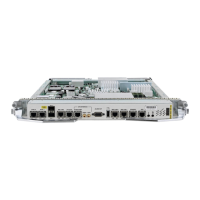In the show spanning-tree mst example output, the first line indicates whether MSTP is operating in dot1q
or the Provider Bridge mode, and this information is followed by details for each MSTI.
For each MSTI, the following information is displayed:
• The list of VLANs for the MSTI.
• For the CIST, the priority and bridge ID of the CIST root, and the external path cost to reach the CIST
root. The output also indicates if this bridge is the CIST root.
• The priority and bridge ID of the root bridge for this MSTI, and the internal path cost to reach the root.
The output also indicates if this bridge is the root for the MSTI.
• The max age and forward delay times received from the root bridge for the MSTI.
• The priority and bridge ID of this bridge, for this MSTI.
• The maximum age, forward delay, max hops and transmit hold-count for this bridge (which is the same
for every MSTI).
• A list of MSTP-enabled interfaces. For each interface, the following information is displayed:
• The interface name
• The port priority and port ID for this interface for this MSTI.
• The port cost for this interface for this MSTI.
• The current port role:
• DSGN—Designated: This is the designated port on this LAN, for this MSTI
• ROOT—Root: This is the root port for the bridge for this MSTI.
• ALT—Alternate: This is an alternate port for this MSTI.
• BKP—Backup: This is a backup port for this MSTI
• MSTR—Master: This is a boundary port that is a root or alternate port for the CIST.
The interface is down, or the bringup delay timer is running and no role has been assigned yet.
• The current port state:
• BLK—The port is blocked.
• LRN—The port is learning.
• FWD—The port is forwarding.
• DLY—The bringup-delay timer is running.
• If the port is a boundary port, and not CIST and the port is not designated, then only the BOUNDARY
PORT is displayed and the remaining information is not displayed.
• If the port is not up, or the bringup delay timer is running, no information is displayed for the
remaining fields. Otherwise, the bridge priority and bridge ID of the designated bridge on the LAN
that the interface connects to is displayed, followed by the port priority and port ID of the designated
port on the LAN. If the port role is Designated, then the information for this bridge or port is
displayed.
L2VPN and Ethernet Services Configuration Guide for Cisco ASR 9000 Series Routers, IOS XR Release 6.3.x
453
Implementing Multiple Spanning Tree Protocol
Configuring MSTP: Examples

